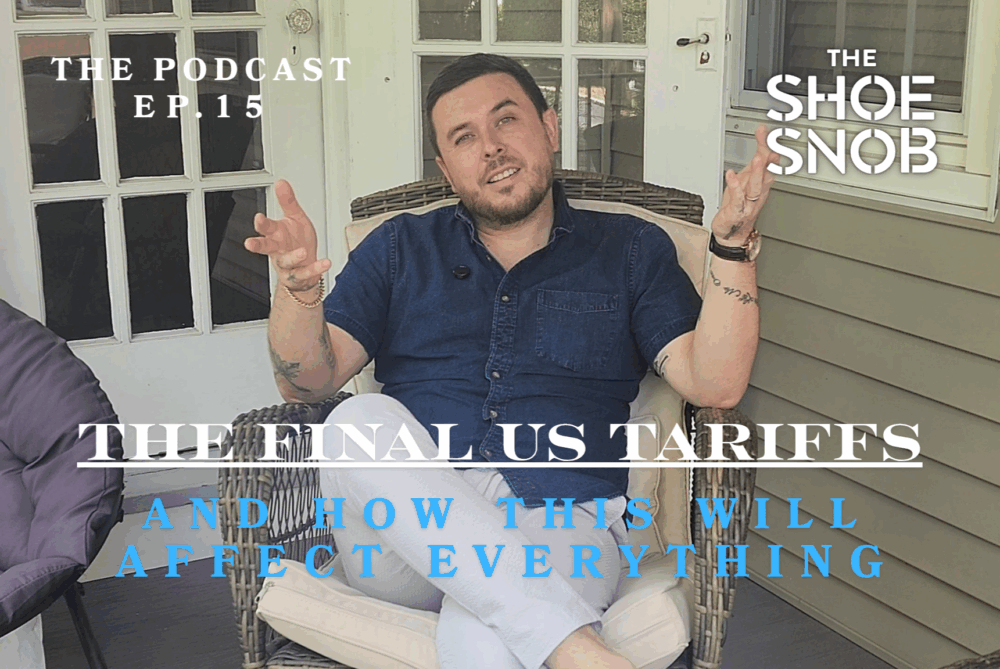
Introduction
The topic of tariffs on shoes has been on everyone’s mind lately — consumers, brands, and retailers alike. As both a consumer and a small business owner of a shoe brand, I’m living this reality firsthand. Tariffs may sound like political jargon, but they directly affect how much we all pay for footwear.
In this post, I want to break down what tariffs really mean, how they work at the border, and why they are about to shake up the shoe industry in a major way.
How Tariffs Work on Imported Shoes
When you import shoes into the U.S., you already pay an import duty — for leather-soled welted shoes, that’s 5%. If I bring in $10,000 worth of goods, the duty alone is $500, plus handling fees charged by shipping companies like FedEx.
That’s how it’s always been — tough but manageable. But then came blanket tariffs on top of those duties. For example, when a 10% tariff was introduced, that same $10,000 shipment suddenly carried $1,600 in total fees ($1000 tariff, $500 duties, & $100 fees). For a small brand with tight margins, that’s not something you can just absorb.
The Jump to 15% (and Beyond)
Recently, we’ve been told that European goods will now carry a 15% tariff. Importantly, this does replace the existing duty (according to what they have said — I have yet to still see a bill). That means my $10,000 shipment would still cost an extra $1600 just in taxes and fees. But still over a $1000 more than I was paying before. And in upfront costs.
For a small shoe company, a 15% additional cost is huge. It forces us — and every other brand — to rethink pricing. And sadly, it is not so easy to ‘make American shoes’ as the manufacturers here are few and cannot compete with European shoemaking in terms of skill. But even if we did, the problem with shoes is that all of the components also come from Europe!
Why Small Businesses Can’t Absorb the Cost
The shoe industry already runs on some of the lowest margins in fashion. Unlike luxury handbags or women’s fashion (where markups can be astronomical), men’s welted shoes rarely carry more than a 3x markup — and often it’s closer to 2x.
When tariffs eat up 15% of the cost, that margin shrinks to an unsustainable level. Unless you’re selling thousands of pairs a month (most of us aren’t), the only option is to raise prices.
The End of the De Minimis Rule
What really triggered this storm was the removal of the de minimis rule, which previously allowed imports under $800 to enter the U.S. tax-free. That’s gone. Now, every single shipment is taxed.
For European and Asian brands, this means they can no longer quietly ship a pair of shoes to U.S. customers without duties. For American consumers, it means unexpected charges at checkout or delivery.
And nobody likes surprise fees.
How Brands Will Adapt
Most brands know customers don’t want to see an extra bill from customs. Instead, they’ll raise retail prices to show you a single, all-inclusive cost. It’s the only way to keep customers from abandoning orders.
Some companies are even considering opening U.S. subsidiaries. By shipping bulk orders into America and then fulfilling domestically, they can reduce import duties — though this adds extra costs and slows down delivery.
What does this mean for you as a shopper? Slower shipping, higher prices, and fewer “deals” on overseas shoes.
What Consumers Should Expect
- Prices will rise across the board starting this fall.
- If a brand doesn’t raise prices but is based overseas, you’ll likely pay the duty yourself.
- American-made shoes aren’t immune either, since many still source uppers or soles abroad.
- By September, almost every brand will be adjusting to survive.
If you’ve been eyeing a pair of shoes from your favorite maker, it may be wise to order before August 29th, when these changes fully take effect at customs.
Final Thoughts
I’ve been warning that change was coming to our industry, and now it’s here. Tariffs on shoes aren’t just a business problem — they’re going to affect every consumer who buys quality footwear.
In one year, I believe the shoe industry will look very different. Prices will be higher, some brands will restructure, and others may not survive. But understanding what’s happening now can help you plan ahead, budget wisely, and make smarter choices as a consumer.
Stay tuned — I’ll keep sharing updates as the situation develops. In the meantime, get your orders in before August 29th, support the brands you love, and let’s hope the shoe world weathers this storm.
—Justin FitzPatrick, The Shoe Snob
